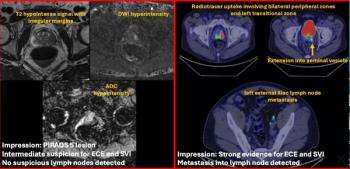
Video game developer wins over PACS
A common flaw among most commercial PACS workstations is inefficient user-workstation interaction, according to a recent paper (J Digit Imaging. 2004;17(2):92-99). It stresses the importance of capturing feedback from radiologists in early stages of
A common flaw among most commercial PACS workstations is inefficient user-workstation interaction, according to a recent paper (J Digit Imaging. 2004;17(2):92-99). It stresses the importance of capturing feedback from radiologists in early stages of development and suggests borrowing ideas from the gaming industry.
The paper cited three limitations of existing workstations:
? Knowledge and understanding are limited by the designers of radiologists' workflow, leading to poor requirements.
? Workstations are still designed by software engineers with no training in psychology or human-computer interaction.
? No usability studies involving radiologists are performed to test design of products in early development.
"PACS vendors seem to be one step behind in addressing radiologists' needs in the context of technological advances in image acquisition,"said Adrian Moise, Ph.D., a computer scientist at Simon Fraser University in Burnaby, BC.
Early radiology workstations were simply digital replacements for light boxes, and tile mode was the norm for image display.
Now, workstations provide support for stack mode, series linking, and simple hanging protocols. Plus technology is evolving rapidly. Multidetector CTs can produce thousands of images in one scan. Computers are also faster, capable of producing 3D reconstruction on the fly.
With most current workstations, radiologists are overloaded with information.
Moise believes next-generation interaction techniques for workstations will use novel input devices and intelligent and adaptive user interfaces. They will rely on data mining, image processing, and CAD to filter out irrelevant information and focus radiologists on critical, heterogeneous data.
"To come up with revolutionary solutions for image display and navigation, we should learn from the gaming industry how to do creative brainstorming rapid prototyping and how to invent domain-specific widgets and input devices," he said.
The Game Studio at Microsoft has 17 employees holding advanced degrees in psychology or human-computer interaction.
"It's probably time for PACS vendors to build such specialized teams," Moise said.
He studied workstation utilization patterns of radiologists involved in reading various modalities. Identifying these patterns was essential to producing an ergonomic solution for workstation controls.
"For example, we suggested window-level, zoom-pan, and image navigation to be always on, allowing these frequently used tools to be located and operated nonvisually and with little cognitive load," he said.
Newsletter
Stay at the forefront of radiology with the Diagnostic Imaging newsletter, delivering the latest news, clinical insights, and imaging advancements for today’s radiologists.




























